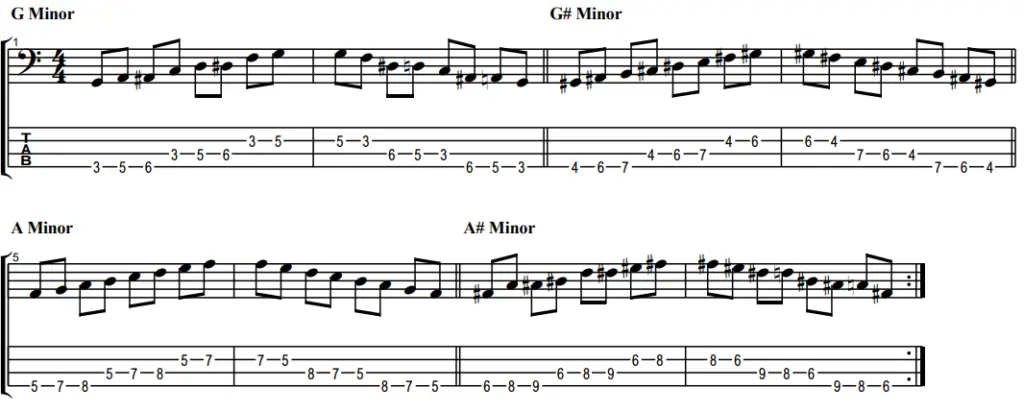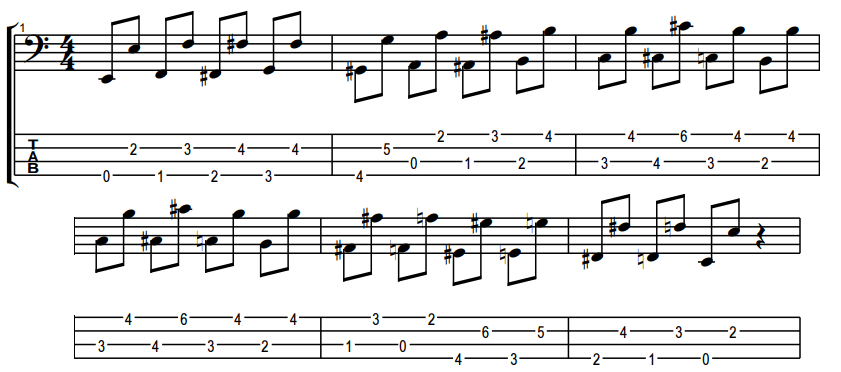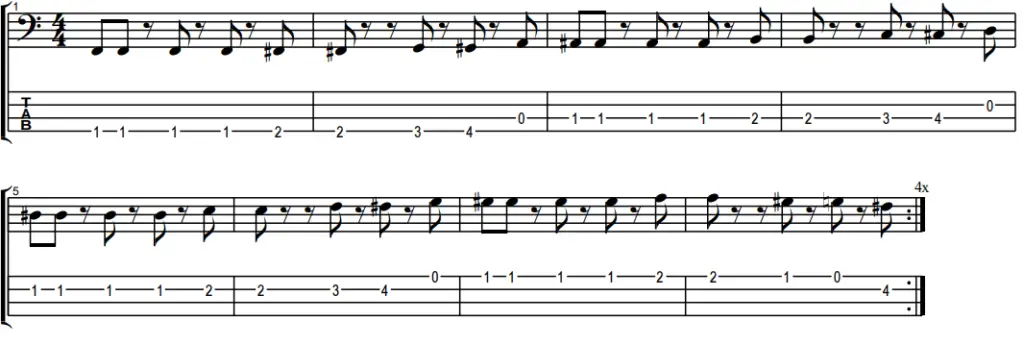What types of bass exercises you use will significantly impact how fast you improve at the bass guitar.
Thus, it is crucial to pick the most helpful and useful ones, especially so when starting out. It is also wise to pick exercises that target parts of your technique that you find the important to improve upon.
For this reason, I have put together a versatile list of 13 helpful bass exercises for beginners.
These focus on everything from dexterity and speed to basic theory and articulation. Thus, you can choose to use all of them to become a more versatile bass player. Alternatively, you can opt to use certain exercises to improve at spesific things.
I recommend playing each exercise as slow as you need to at first. Then, as you become comfortable and can play the exercise with control, speed it up. This way you will make the most out of each of them, as well as improve your control of your bass guitar in the process.
1. Scales
- Best for: Dexterity, Memorizing the fretboard, Warm-up, Pattern recognition
When I warm up to play the bass, I always start by playing scales. I`ve done this for more than a decade now and i consider them a great way to make the most of bass practice sessions.
When I was a beginner, they were great for learning the fretboard of the bass. As most music is written in major and minor scales, they were thus great for learning all the patterns I would later encounter in bass lines.
I still practice scales today, because they double as a finger dexterity exercise and a great for warming up tool. Thus, scales makes for great exercises regardless of what your current skill-level is.
There are two main ways of playing scales that I find to be the most helpful. First, when learning a new scale, I recommend playing the scale again and again til you know it by heart.
If you are unfamiliar with the minor and major scales, start with those. Here are what the G minor and G major scales look like on the bass:

The great thing about this basic exercise is that it teaches you to play the minor and major scale in any key.
This becomes apparent in the second way of practicing scales. Namely, by moving up the fretboard of the bass by playing a scale in various keys.
Here is what that looks like using the minor scale:

To begin with, start with these two ways of practicing scales. I recommend using the first one until you remember the major and minor scale by heart, and then sticking to exercise 1.2.
As this becomes second nature, you can apply the same exercises to any scale you want. Aside from minor and major, different genres tend to use vastly different scales. For an example of why check out my article on metal bass scales.
Related reading: Alternatively, I`ve also written a full article on essential jazz bass scales.
2. Seconds
- Best for: Control, Coordination, Common Pattern
The minor and major second are the two shortest bass guitar intervals. This means that you only have to move your finger one fret to play a minor second or 2 frets to play a major second.
As a result, practicing seconds is great for developing control of your fretting hand. They are also great for working on the coordination of your fingers.
The bass exercise below consists of ascending major seconds and descending minor seconds. It also moves across strings in an easy and intuitive pattern, making it great for beginners.

As you become comfortable with this exercise, you can try playing a different pattern, such as 1-2-4-3 or 1-3-4-2. You can also play the exercise one step higher (2-4-3-5) and repeat the same pattern as you move up the strings.
Bassists often use seconds to move up or down to the root note of a chord, and they are thus a big part of what makes bass lines sound groovy. Thus, I recommend practicing seconds, as they are comonnly used in bass lines.
3. Thirds
- Best for: Dexterity, Control
A minor third consists of a 1-and-a-half step interval, whereas a major third consists of a 2-step interval.
As a result, playing exercises that are centered around thrids are amazing for developing your dexterity and ability to move between strings.
The exercise below simply consists of ascending and then descending the F Major scale by playing thirds. This just so happens to make for one of the best dexterity exercises a bassist can play. Plus, it sounds really cool for an exercise.

Thirds are moderatley common in bass lines, but not used as frequently as some other intervals. It is however benefical to have some experience playing them, and they make for a great general exercise.
4. Speed
- Best for: Controlled plucking, developing speed
Knowing your intervals and developing dexterity is great, but what about speed?
Through the years I`ve tried countless different methods for trying to play faster. After more hours of trial and error than I`d like to admit, I`ve personally found that the best way to become faster at the bass is to simply practice playing 8th notes at gradually increasing tempos.
Granted, an important part of this way of practicing is that you are able to play with control before you increase the tempo.
Thus, set a tempo, practice til you can play 8th notes with control, and increase the tempo. That`s all there is to it. For a balanced way of practicing speed, I recommend switching between open strings every 4 notes like this:

To put more emphasis on finger dexterity, play the notes in pairs instead.

And to focus on strictly developing speed when plucking one string, play the same note for the entire bar:

In the beginning, I recommend starting really slow with a tempo of 60-80 BPM or so.
This will feel overly slow. However, focusing on developing your control instead of trying to play as fast as you can immideatley, will make you able to play faster in the long run. It sounds unintuitive, but I can tell you from experience that this will positively impact how quickly you can learn the bass.
5. Fifths
- Best for: Flexibility, Common technique
Perfect Fifths are extremely common in bass lines. You can play them under almost any chord, and the interval makes up the two notes that are used to play power chords on the bass
Most importantly, fifths provide a lot of movement to bass lines without sounding intrusive or out of place. As you might have guessed, this also means that you will find them in countless bass lines.
The easiest way to play fifths is 2 frets up, 1 string higher. This also makes fifths helpful for developing the flexibility of your fingers in addition to being an important interval. I recommend the following exercise.

Similar to seconds, this is a great exercise to play at various parts of the neck. When you become comfortable with the above exercise, I thus recommend playing it at different parts of the neck.
6. Triads
- Best for: Dexterity, Muting, Playing Chords
Triads consist of 3 notes that are seperated by either a minor or major third interval.
The most common types of chords, such as the major and minor chords, consist of 3 notes. The root note, a minor or major third, and a fifth. Together, these 3 notes are called triads, as they are all seperated by a minor or major third from one another.
Thus, this combination of notes is the bread and butter of playing melodic bass lines.
Using both the third and fifth, they also make for great exercises that allow you to utilize the whole fretboard. I like practicing them in the following patterns:


Due to the finger movement requires for this exercise, you might find it hard to dampen the bass strings. This means that unplayed strings might ring out unintentionally, which results in a muddy and unpleasant sound.
Thus, this exercise doubles as a helpful tool for practicing muting the strings. Pick players commonly mute strings by using the palm of their plucking hand to rest against unplayed strings. Finger-style players most commonly use the floating thumb technique or anchor their thumb on the deepest unplayed string.
7. Octaves
- Best for: Flexibility, Common technique
Octaves are an integral part of bass lines in almost every single genre. In some genres, such as disco and funk, entire bass lines sometimes even consist solely of octaves.
However, they can be somewhat tricky, as they require you to jump 6 whole steps up in pitch. As a result, the best way to play them is 2 frets higher, 2 strings above.
Thus, out of all the great flexibility exercises on this list, this is among the best. I recommend practicing them in the following manner, as this targets all of your fingers across all 4 strings.

There is a good reason the octave is marked with two dots on the bass, and it`s a key interval that all bassists should become familiar with playing.
With that said, octaves can quickly take a toll on your stamina. Thus, be careful about practicing them for long stretches at a time when starting out.
8. Syncopation & Rests
- Best for: Feel, Groove, Sense of Rhythm
A big reason the bass is a hard instrument to master is that groove and articulation can only be developed with time.
With that said, there are exercises you can do to speed up the process.
One way to target these areas of your playing is to practice rests and syncopated bass lines.
A rest means that you are simply not playing anything. While that sounds easy enough, the hard part lies in making notes sound consistent when they are followed or proceeded by a rest.
Syncopation means that a bass line accentuates the backbeat. If the main groove or melody of a song accentuates the first beat, a syncopated bass line will accentuate the second. This makes bass lines sound groovy, but it takes some time to develop a feel and sense of rhythm to play syncopated lines well.
Thus, here is an exercise that will teach you both of these key skills:

During this exercise, pay extra attention to whether the notes you are playing differ in their intensity. Are some louder than others? Is every note ringing out for equally long before and after the rests?
If so, practice making them sound as similar and consistent as you can. This will develop both your sense of rhythm, as well as your ability to control how you articulate notes.
9. Descending Thirds & Seconds
- Best for: Dexterity, Flexibility
To combine some of the skills you have learned above, here is an exercise that uses both thirds and seconds.

This one is particularly useful for developing your dexterity and flexibility, as makes both small and big leaps across the strings.
Thus, I recommend incorporating this bass exercise into your practice sessions when you become comfortable with exercises #2 and #3. it also doubles as a great way to warm-up if you need a break from playing scales.
10. 3/4 Time
- Best for: Sense of rhythm, timing, articulation
The vast majority of common music is written in 4/4 time. There is however a decent chuck of music that is written in 3/4 time as well.
Thus, as a bass player, it is beneficial to have some experience with this time signature.
Instead of counting 4 beats per bar, 3/4 time requires you to count 3. Usually, this is done by either accentuating the one, one-two-three, or the three, one-two-three.
The below bass exercise feels most natural to me when I count the one as the strong beat. You can also count it as one-two-three if this feels more natural to you.

It is important to count and feel the notes as pairs of two, and not as sets of three. Counting them in sets of 3s would result in them feeling more like triplets than quarter notes, and would incorrectly make it feel more like 4/4 time.
Playing bass in 3/4 time is important for its own sake, but it’s worth mentioning that it will also improve your overall sense of rhythm. As a result, this exercise will also improve your ability to play in 4/4 time and improve your general timing.
11. 5/4 Time
- Best for: Sense of rhythm, timing, articulation
5/4 time is a less common time signature. Therefore, It is also not crucial that you become proficient at it.
However, for the same reason, that playing in 3/4 time is useful for a multitude of reasons, 5/4 can make for great exercises. Practicing it improves your articulation and sense of rhythm, and is thus a fitting next step after 3/4 starts to feel natural to play.
I generally count 5/4 time as one-two-three-four-five. This can be difficult at first, as you essentially have two different rhythms inside the same bar. For the same reason, it will greatly improve your timing when you get a hang of it.

I recommend using this exercise after you get a good grasp of playing in 3/4, and as a fun way to mix things up during practice sessions. It is useful, but not essential.
12. Sixths
- Best for: Flexibility, Muting
Major and minor sixths are not as important of an interval as the second, third, fifth, and octave. However, they can be a great way to spice up a bass line. Most importantly, they certainly make for great finger flexibility exercises.
This is because they require you to either play 3 to 4 frets up, 1 string higher, or 1 to 2 frets down, 2 strings higher.
For that reason, I like doing this exercise which combines both ways of playing this interval.

Similar to playing octaves, this is a stamina-draining exercise. Combining this with the fact that sixths are not that common of an interval, I recommend using this exercise intermittently in order to build finger flexibility.
13. High Thirds
- Best for: Flexibility, Muting, E to G string movement
Lastly, we are going to revisit playing thirds. Only this time, we are going to be playing them an octave higher.
This means that minor thirds can be reached at the same fret 3 strings up, while major triads can be reached 1 fret higher, 3 strings up.
Thus, practicing them will emphasize your ability to move between the E and G strings.
Related reading: How to remember bass string names
While most bass lines don`t make leaps this big, it is only a question of time before you run into one that does. Thefore, it is helpful to have some experience with switching between the deepest and thinnest string on your bass. Here`s a fitting exercise for just that:

This large leap between the two notes can make it hard to keep both strings muted. Thus, similar to playing triads, this doubles as a great exercise in muting strings.
Closing words
These exercises alone will give you enough to practice for a lifetime. I still use many of them after playing bass for 15 years and find them to be helpful to this day.
With that said, I also find it important to not focus excessively on just playing bass exercises. Learning the bass should first and foremost be fun, so if they become tedious, feel free to take a look at some easy bass tabs instead.
Lastly, after practicing these exercises for a bit, you might find that they start to feel like second nature. A good thing to do then is to see whether you can play the bass without looking as you practice them.
This will help you develop further control of your instrument. It is when you can do that, and play the exercises with even articulation and without strings ringing out that you will have made the most of them.

